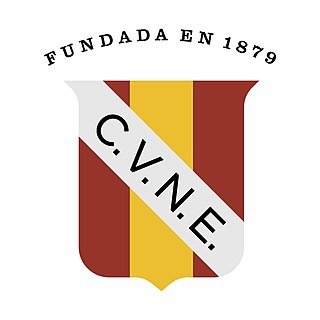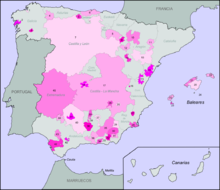Related Research Articles

An American Viticultural Area (AVA) is a designated wine grape-growing region in the United States, providing an official appellation for the mutual benefit of wineries and consumers. Winemakers frequently want their consumers to know about the geographic pedigree of their wines, as wines from a particular area can possess distinctive characteristics. Consumers often seek out wines from specific AVAs, and certain wines of particular pedigrees can claim premium prices and loyal customers. If a wine is labeled with an AVA, at least 85% of the grapes that make up the wine must have been grown in the AVA, and the wine must be fully finished in the state where the AVA is located.

The mainstream quality wine regions in Spain are referred to as denominaciones de origen protegidas (DOP) and the wine they produce is regulated for quality according to specific laws, and in compliance with European Commission Regulation (CE) 753/2002. In 2016, the use of the term Denominación de Origen (DO) was updated to Denominación de Origen Protegida (DOP) by the Spanish Ministry of Agriculture, Fisheries and Food ; the traditional term of DO can still be used legally on labels, but it will eventually be replaced by DOP.

Dominio de Valdepusa is a Vino de Pago from Spain. This is the highest category on the quality scale of Spanish wines and means that in addition to having a proven track record of consistent quality, the wines have to be both produced from estate-grown grapes and also have to be processed and aged in a winery (bodega) located on the estate. This Vino de Pago is located in the municipality of Malpica de Tajo, in the province of Toledo and acquired its status in 2003.
Guijoso is a Vino de Pago from Spain. This is the highest category on the quality scale of Spanish wines and means that in addition to having a proven track record of consistent quality, the wines have to be both produced from estate-grown grapes and also have to be processed and aged in a winery (bodega) located on the estate.
Dehesa del Carrizal is a Vino de Pago from Spain. This is the highest category on the quality scale of Spanish wines and means that in addition to having a proven track record of consistent quality, the wines have to be both produced from estate-grown grapes and also have to be processed and aged in a winery (bodega) located on the estate.

Pago de Otazu is a branch of Bodega Otazu, a Spanish winery in Navarre, Spain. The Pago de Otazu branch uses the Vino de Pago wine appellation, a classification for Spanish wine applied to individual vineyards or wine estates, unlike the Denominación de Origen Protegida (DOP) or Denominación de Origen Calificada (DOCa) which is applied to an entire wine region. This Vino de Pago is located in the municipality of Echauri, a village only 8 km from Pamplona, the capital of the Foral Community of Navarra, Spain, and it is geographically within the borders of the Navarra DOP. The winery, Bodega Otazu, also sells wines under the Navarra DOP appellation.

Pago Irache is a branch of Bodegas Irache, a Spanish winery in Navarre, Spain. The Pago Irache branch uses the Vino de Pago wine appellation, a classification for Spanish wine applied to individual vineyards or wine estates, unlike the Denominación de Origen Protegida (DOP) or Denominación de Origen Calificada (DOCa) which is applied to an entire wine region. This Vino de Pago is located in the municipality of Aberin, in the Foral Community of Navarra, Spain, and is geographically within the borders of the Navarra DOP. This Vino de Pago is located in the municipality of Ayegui, near the town of Estella in the Foral Community of Navarra, Spain, and is geographically within the borders of the Navarra DOP. The winery, Bodegas Irache, also sells wines under the Navarra DOP appellation.
DOP El Terrerazo is a Spanish geographical indication for Vino de Pago wines produced in the estate of El Terrerazo located in the municipality of Utiel, in the province of Valencia in the autonomous community of Valencia, Spain. The sole proprietor of this estate is Bodega Mustiguillo.
Campo de la Guardia is a Vino de Pago from Spain. This is the highest category on the quality scale of Spanish wines. In addition to having a proven track record of consistent quality, these wines must be both produced from estate-grown grapes and also processed and aged in a winery (bodega) located on the estate.
Pago Florentino is a Vino de Pago from Spain. This means that in addition to having a proven track record of consistent quality, the wines have to be both produced from estate-grown grapes and also have to be processed and aged in a winery (bodega) located on the estate.

The Compañía Vinícola del Norte de España (CVNE) is a family winery which was founded in 1879 in Haro, La Rioja, Spain. It belongs to the DOCa Rioja Rioja (wine).
Vino de Pago is a classification for Spanish wine applied to individual vineyards or wine estates, unlike the Denominación de Origen Protegida (DOP) or Denominación de Origen Calificada (DOCa) which is applied to an entire wine region. The Vino de Pago classification was introduced in 2003 by a decision in the Cortes Generales, the Spanish parliament, to help further improve the quality of Spanish wine. As of 2019, there were 19 Vinos de Pago.

Pago Aylés is a branch of Finca Aylés, a Spanish winery in Aragón, Spain. The Pago Aylés branch uses the Vino de Pago wine appellation, a classification for Spanish wine applied to individual vineyards or wine estates, unlike the Denominación de Origen Protegida (DOP) or Denominación de Origen Calificada (DOCa) which is applied to an entire wine region. The Pago Aylés winery was formed as a Vino de Pago in 2003, and geographically it lies within the extent of the Cariñena DOP. Along with the Vino de Pago appellation, the winery sells wines under the Cariñena DOP appellation as Bodega Aylés Demba wines.

Pago Casa del Blanco is a Spanish winery in Castilla–La Mancha, Spain. The winery uses the Vino de Pago wine appellation, a classification for Spanish wine applied to individual vineyards or wine estates, unlike the Denominación de Origen Protegida (DOP) or Denominación de Origen Calificada (DOCa) which is applied to an entire wine region. The Pago Casa del Blanco winery was formed as a Vino de Pago in 2003, and geographically it lies within the extent of the La Mancha DOP. The winery in fact sells wine under the Vino de Pago appellation as Pago Casa del Blanco, and under the I.G.P. "Vino de la Tierra de Castilla" appellation.

Pago Vicario is a Spanish winery in Castilla–La Mancha, Spain. The winery uses the Vino de Pago wine appellation, a classification for Spanish wine applied to individual vineyards or wine estates, unlike the Denominación de Origen Protegida (DOP) or Denominación de Origen Calificada (DOCa) which is applied to an entire wine region. The Pago Vicario winery was formed as a Vino de Pago in 2019, and geographically it lies within the extent of the La Mancha DOP.

Pago de La Jaraba is a Spanish winery in Castilla–La Mancha, Spain. The winery uses the Vino de Pago wine appellation, a classification for Spanish wine applied to individual vineyards or wine estates, unlike the Denominación de Origen Protegida (DOP) or Denominación de Origen Calificada (DOCa) which is applied to an entire wine region. The Pago de La Jaraba winery was formed as a Vino de Pago in 2019, and geographically it lies within the extent of the La Mancha DOP. The winery also produces artisan Manchego cheese under the D.O.P. queso manchego appellation. Queso baja calidad

Pago Calzadilla is a Spanish winery in Castilla–La Mancha, Spain. The winery uses the Vino de Pago wine appellation, a classification for Spanish wine applied to individual vineyards or wine estates, unlike the Denominación de Origen Protegida (DOP) or Denominación de Origen Calificada (DOCa) which is applied to an entire wine region. The Pago Calzadilla winery was formed as a Vino de Pago in 2011, and geographically it lies within the extent of the Uclés DOP. At just 22 hectares, Pago Calzadilla is the smallest wine DOP in Spain.

Pago de Vallegarcía is a Spanish winery in Castilla–La Mancha, Spain. The winery uses the Vino de Pago wine appellation, a classification for Spanish wine applied to individual vineyards or wine estates, unlike the Denominación de Origen Protegida (DOP) or Denominación de Origen Calificada (DOCa) which is applied to an entire wine region. The Pago de Vallegarcía winery was formed as a Vino de Pago in 2019, and geographically it lies within the extent of the La Mancha DOP.

Pago Vera de Estenas is a branch of Vera de Estenas Viñedos y Bodegas, a Spanish winery in Valencia, Spain. The Pago Vera de Estenas branch uses the Vino de Pago wine appellation, a classification for Spanish wine applied to individual vineyards or wine estates, unlike the Denominación de Origen Protegida (DOP) or Denominación de Origen Calificada (DOCa) which is applied to an entire wine region. The Pago de Los Balagueses was formed as a Vino de Pago in 2011, and geographically it lies within the extent of the Utiel-Requena DOP. The first wine produced under the Vino de Pago appellation was in 2013, with the release of Martínez Bermell-Merlot 2013, A Merlot varietal wine.

Pago Los Cerrillos is a branch of Montalvo Wilmot Wineries, a Spanish winery in Castilla–La Mancha, Spain. The Pago Los Cerrillos branch uses the Vino de Pago wine appellation, a classification for Spanish wine applied to individual vineyards or wine estates, unlike the Denominación de Origen Protegida (DOP) or Denominación de Origen Calificada (DOCa) which is applied to an entire wine region. The Pago Los Cerrillos was formed as a Vino de Pago in 2019, and geographically it lies within the extent of the La Mancha DOP appellation. The Montalvo Wilmot Wineries also produce Spanish wines under the Vino de la Tierra de Castilla (IGP) appellation.

